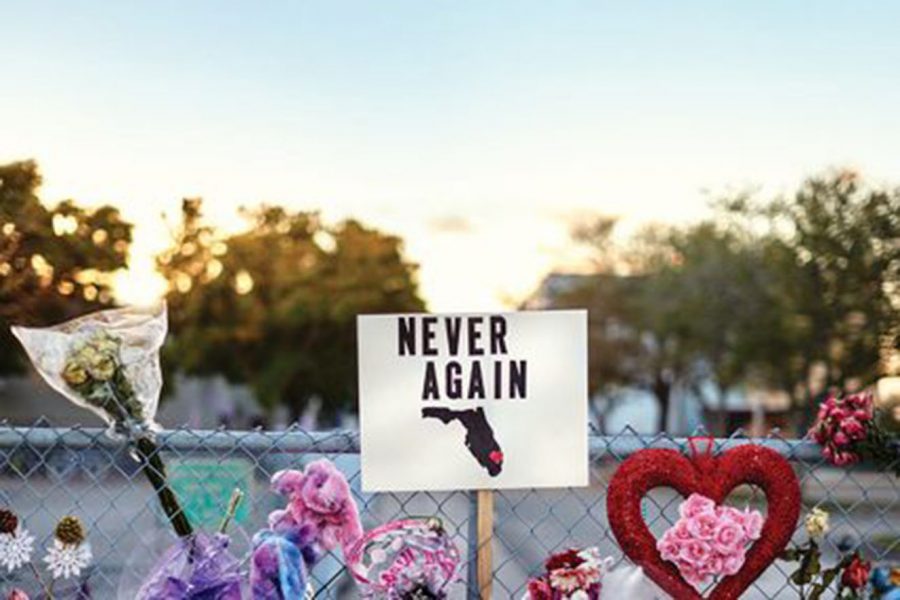Missed the mark
US fails to do enough in a year after major shooting
Photo by HarperCollins Publishers/TNS
One year ago a fatal school shooting took place in Parkland, Florida and shocked the nation. The anniversary of this event reminds the country that gun control is still a topic that should be closely examined.
March 8, 2019
Thousands of students and adults bowed their heads in a moment of silence. Feb. 14 marked the one year anniversary of the Marjory Stoneman Douglas shooting in Parkland, Florida that killed 17 people.
The moment of silence began at 10:17 a.m., denoted to the 17 slain. Stoneman Douglas students arrived at school wearing #MSDStrong T-shirts, walking past clear plastic figurines of angels erected for the 14 students and three staff members killed.
The shooting led to the student-based political movement, the March for Our Lives campaign, advocating stricter gun laws and mobilizing a new generation of voters. This movement reflects the changing views on gun laws in the younger population of the United States, but the permanence of this shift is not guaranteed.
WARNING SIGNS IGNORED
Part of the increased upset comes from the lack of accountability or intervention to prevent this tragedy. While Nikolaz Cruz was still a student at Marjory Stoneman Douglas, administrators were warned that he was looking up guns and said he liked to “see people in pain.” This was another episode among many that blatantly showed the impending and likely preventable massacre.
Years before Parkland, Cruz warned people about the rampage he was planning. The FBI, however, neglected to address the ominous signs, including a tip to the national call center about Cruz. This episode has caused many questions over the interests of politicians and the government in preventing school shootings. The lack of gun laws seem to support this.
GUN LAWS
According to Giffords Law Center, an organization to prevent gun violence, 26 states and the District of Columbia have enacted 67 gun control laws this year, including a raised minimum age to buy guns and additional waiting periods for purchases. A number of states that enacted “red flag,”laws that allow temporary confiscation of weapons, also doubled.
Gallup’s surveys suggest that support for stricter gun laws in March 2018, a month after the shooting, have increased to 67 percent, up from 60 percent in October 2017 and 55 percent in 2016. It did, however, drop again to 61 percent the following October. Though Parkland showed a slight increase in stricter laws, the survey shows stagnant results.
State gun laws are broken down, as to be expected, with laxer laws in states controlled by Republicans and stricter laws in those controlled by Democrats. Democratic state legislatures passed twice the amount of gun restrictions than Republicans in 2018, most spurred to action in the post-Parkland wake.
Legislatures, Republican and Democratic, passed 76 gun laws. Among these was the Florida State Law 7026, or the “Marjory Stoneman Douglas High School Public Safety Act”, that pledged $400 million to school safety and community mental health efforts. Overall, more than half of all states passed a minimum of one gun control measure in 2018.
In the year following the shooting, nearly 1,200 more children have died because of gun violence. The Trace, a nonprofit news organization focused on gun statistics, recently launched a website, “Since Parkland”, compiling the profiles of these victims, presenting them as more than another statistic on the chart of increasing gun violence.
STALEMATE
It seems that at the federal level, efforts of change seem to be in partisan gridlock. Republican leaders have been quiet and the White House seems to change its mind between visits with survivors and the NRA. With a Republican Senate and president, the likelihood of gun law reform is slim.
One thing is clear after the shooting — Americans are fed up with gun violence. The March for Our Lives protests numbered in the hundreds of thousands and was one of the biggest youth-led protests. A poll by NBC News and the Wall Street Journal cited America’s second greatest concern was mass shootings.















